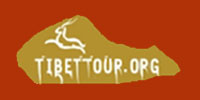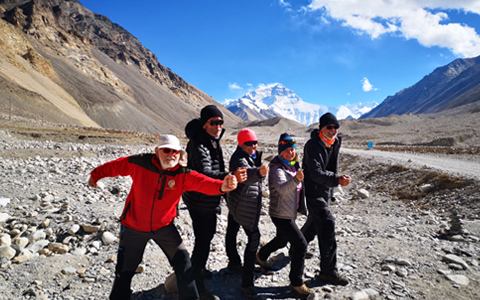When planning a trip to Lhasa, it’s important to consider its altitude. Though Lhasa is higher than many cities at lower elevations, it’s lower than some other Tibetan landmarks. In this article, we’ll explore Lhasa’s elevation, the heights of major attractions, and essential tips for preventing and managing altitude sickness. Read on to prepare for a safer and smoother visit to Lhasa.
How High is Lhasa? Lower Than Many Other Places in Tibet
Lhasa sits at an altitude of about 3,656 meters (11,995 feet) above sea level. While this is quite high compared to many places worldwide, it's lower than many other spots in Tibet, like Everest Base Camp or Lake Namtso, which are at even higher elevations. Because of this, Lhasa is a perfect starting point for travelers before heading to the higher altitudes in Tibet.
Lhasa's terrain slopes from east to west, with higher elevations in the north and lower areas in the south. Nestled within a valley surrounded by towering mountains, the city offers stunning views while being relatively flat along the banks of the Lhasa River. This gentle terrain makes Lhasa easier to explore compared to the rugged, mountainous regions found in other parts of Tibet.
What are the Altitudes of Major Attractions in Lhasa?
Lhasa is home to several world-renowned attractions, each at varying altitudes. Here’s a closer look at the elevations of some key sites you may visit:
(1) Potala Palace: 3,700 meters (12,139 feet)
The Potala Palace, an iconic symbol of Tibetan Buddhism, stands at an elevation of 3,700 meters. Once the winter residence of the Dalai Lamas, it is now a UNESCO World Heritage site. Its altitude, combined with steep staircases, can pose a challenge for those not yet acclimatized. To fully enjoy your visit, it's best to explore the Potala Palace on the second or third day after arrival, giving your body time to adjust to the high altitude.
 It's best to explore the Potala Palace on the second or third day after arrival in Lhasa.
It's best to explore the Potala Palace on the second or third day after arrival in Lhasa.(2) Jokhang Temple: 3,650 meters (11,976 feet)
Jokhang Temple, the most sacred site in Tibetan Buddhism, sits at an altitude of 3,650 meters. With over 1,300 years of history, it is home to the revered Jowo Shakyamuni statue. Surrounded by the bustling Barkhor Street, the temple is a focal point for both Tibetan pilgrims and tourists, offering a glimpse into the spiritual heart of Tibet.
 Jokhang Temple sits at an altitude of 3,650 meters.
Jokhang Temple sits at an altitude of 3,650 meters.(3) Barkhor Street: 3,650 meters (11,976 feet)
Surrounding the Jokhang Temple, Barkhor Street is a vibrant market and a key pilgrimage route. As you stroll through this lively area, you can join devout pilgrims in performing the kora, a traditional circumambulation of the temple. Additionally, the street is a bustling hub for shopping, where you can find a variety of Tibetan souvenirs, from handcrafted jewelry to traditional textiles.
 Barkhor Street is a vibrant market and a key pilgrimage route in Lhasa.
Barkhor Street is a vibrant market and a key pilgrimage route in Lhasa.(4) Sera Monastery: 3,700 meters (12,139 feet)
Perched on Serawoze Mountain in the northern suburbs of Lhasa, Sera Monastery sits at 3,700 meters and is one of the "Great Three" Gelugpa monasteries. It's famous for its lively monk debates, which you can usually catch in the courtyard during the afternoon.
 Sera Monastery is famous for its lively monk debates.
Sera Monastery is famous for its lively monk debates.(5) Drepung Monastery: 3,800 meters (12,467 feet)
Situated slightly higher at 3,800 meters, Drepung Monastery is one of the largest monasteries in Tibet and is also one of the Great Three. Located about 10 kilometers south of downtown Lhasa, its elevated position and expansive grounds make it a key site for understanding Tibetan monastic life.
 Visiting the Drepung Monastery, one of the largest monastery in Tibet.
Visiting the Drepung Monastery, one of the largest monastery in Tibet.(6) Ganden Monastery: 3,800 meters (12,467 feet)
Another significant monastery, Ganden Monastery, also sits at 3,800 meters. As the third of the "Great Three" Gelug monasteries, it offers breathtaking views of the surrounding landscape. Unlike the other monasteries mentioned, Ganden is further, about 50 kilometers from Lhasa. It’s a great idea to visit Ganden Monastery after spending a few days acclimatizing and sightseeing in Lhasa.
 Ganden Monastery is the first monastery of the Gelug Sect of Tibetan Buddhism.
Ganden Monastery is the first monastery of the Gelug Sect of Tibetan Buddhism.(7) Norbulingka Palace: 3,650 meters (11,976 feet)
The Norbulingka Palace, perched at 3,650 meters, served as the summer residence of the Dalai Lamas. Its lush gardens and elegant architecture offer a refreshing contrast to the more austere monasteries. Each year, the gardens also host the vibrant Shoton Festival in Lhasa.
 Norbulingka Palace, with its lush gardens and elegant architecture, is a great destination in Lhasa.
Norbulingka Palace, with its lush gardens and elegant architecture, is a great destination in Lhasa.(8) Lake Namtso: 4,718 meters (15,479 feet)
Lake Namtso, one of Tibet’s Great Three Holy Lakes, is a popular destination located 200 kilometers north of Lhasa. At an elevation of 4,718 meters, it’s much higher than Lhasa, offering a dramatic contrast. On the journey from Lhasa to Namtso Lake, you'll traverse expansive grasslands and cross the high Lagenla Pass at 5,190 meters. It's advisable to spend a few days acclimatizing in Lhasa before making the trip to Namtso Lake.
 At an elevation of 4,718 meters, Namtso Lake is much higher than Lhasa.
At an elevation of 4,718 meters, Namtso Lake is much higher than Lhasa.Is It Easy to Get Altitude Sickness in Lhasa? How to Prevent It?
Altitude sickness, or acute mountain sickness (AMS), happens when your body struggles to adjust to lower oxygen levels at high altitudes. Symptoms may include headaches, nausea, dizziness, and fatigue.
Although Lhasa’s elevation can cause altitude sickness in some visitors, its altitude is generally manageable with proper acclimatization and precautions. To help prevent altitude sickness during your visit to Lhasa, keep these important tips in mind:
(1) Prepare Physically Before Arriving in Lhasa: Stay fit by maintaining a regular exercise routine like running, cycling, or swimming. These activities can help build stamina and prepare your body for the high-altitude conditions in Tibet.
(2) Walk Slowly and Avoid Strenuous Exercise: In high-altitude environments, walking slowly helps conserve oxygen. Avoid intense physical activity, as it increases your oxygen needs and can worsen altitude sickness symptoms.
 Walking slowly to prevent altitude sickness in Lhasa.
Walking slowly to prevent altitude sickness in Lhasa.(3) Avoid Showers for the First Few Days: Showers can consume a lot of oxygen and increase the risk of catching a cold, which can worsen altitude sickness. It’s best to wait at least three days after arriving in Lhasa before taking a shower to allow your body time to acclimate.
(4) Drink Plenty of Water: Lhasa’s dry climate means it’s crucial to stay hydrated. Drinking more water helps your body adjust to the high altitude and keeps you feeling better.
(5) Stay Warm and Avoid Getting Cold: Lhasa’s weather can be unpredictable, with significant temperature changes between morning and evening. Keeping warm is important to prevent catching a cold, which can affect your overall enjoyment of your trip.
(6) Eat Light Meals and Drink Properly: Choose light, easily digestible foods, as heavy meals can make you feel uncomfortable at high altitudes. Also, avoid alcohol and smoking, as they can hinder your body’s ability to acclimate and worsen altitude sickness symptoms.
(7) Take Proper Medication: Some travelers may benefit from taking medications like acetazolamide (Diamox) to aid in acclimatization. Consult your doctor or pharmacist before your trip if you plan to use medication to prevent or relieve altitude sickness.
What to Do If I Suffer from Altitude Sickness while Visiting Lhasa?
It’s possible to experience altitude sickness while visiting Lhasa, but don’t worry! If it happens, there are a few simple steps you can take to feel better:
(1) Keep a positive attitude: Staying calm and relaxed is key to easing altitude sickness. Excessive worry can make symptoms worse, while a positive mindset can help reduce discomfort. Though it’s not guaranteed, staying upbeat does make a difference.
(2) Don't panic if symptoms arise: If you experience altitude sickness, stay calm and inform your tour guide right away. They can offer guidance and arrange medical help if needed. Most accommodations in Lhasa have oxygen equipment to help relieve discomfort.
(3) Bring altitude sickness medication: Consider bringing anti-altitude sickness remedies like Rhodiola rosea or purchasing local treatments such as Gaoyuan An. While these can help, always follow the advice of a doctor and use medication as directed for safety.
(4) Use oxygen sparingly: Inhaling oxygen can temporarily relieve headaches caused by altitude sickness, but it’s not a long-term solution. Don’t become overly reliant on oxygen—let your body gradually adjust to the high altitude. Oxygen tanks are widely available at pharmacies in Lhasa if needed.
(5) Seek medical treatment for severe symptoms: If you experience severe symptoms like persistent headaches, nausea, or vomiting, head to the hospital for treatment. Hospitals often provide glucose injections to boost blood oxygen levels.
(6) Evacuate if necessary: If altitude sickness becomes serious, it’s best to leave Lhasa and head to a lower-altitude area immediately.
Further Tips: Spend a Few Days in Lhasa Before Going to Higher Places in Tibet
If you're planning to visit Everest Base Camp or other high-altitude areas in Tibet, it's recommended to spend a few days in Lhasa first to acclimate. This gives your body time to adjust to the altitude, lowering the risk of altitude sickness when you head to higher elevations. Meanwhile, you can explore Lhasa’s attractions, experience the local culture, and prepare yourself for the journey ahead.
Conclusion
Lhasa, while lower than many other Tibetan destinations, still requires some adjustment due to its altitude. By taking preventive measures and understanding how to manage altitude sickness, you can ensure a more comfortable and enjoyable visit. As a leading local tour operator, we are here to help you have a safe and pleasant trip with well-planned itineraries and thoughtful local guides. If you have any questions or are ready to book your tour, feel free to contact us today.


























 It's best to explore the Potala Palace on the second or third day after arrival in Lhasa.
It's best to explore the Potala Palace on the second or third day after arrival in Lhasa. Jokhang Temple sits at an altitude of 3,650 meters.
Jokhang Temple sits at an altitude of 3,650 meters. Barkhor Street is a vibrant market and a key pilgrimage route in Lhasa.
Barkhor Street is a vibrant market and a key pilgrimage route in Lhasa. Sera Monastery is famous for its lively monk debates.
Sera Monastery is famous for its lively monk debates. Visiting the Drepung Monastery, one of the largest monastery in Tibet.
Visiting the Drepung Monastery, one of the largest monastery in Tibet. Ganden Monastery is the first monastery of the Gelug Sect of Tibetan Buddhism.
Ganden Monastery is the first monastery of the Gelug Sect of Tibetan Buddhism. Norbulingka Palace, with its lush gardens and elegant architecture, is a great destination in Lhasa.
Norbulingka Palace, with its lush gardens and elegant architecture, is a great destination in Lhasa. At an elevation of 4,718 meters, Namtso Lake is much higher than Lhasa.
At an elevation of 4,718 meters, Namtso Lake is much higher than Lhasa. Walking slowly to prevent altitude sickness in Lhasa.
Walking slowly to prevent altitude sickness in Lhasa.











Ask a Quick Question